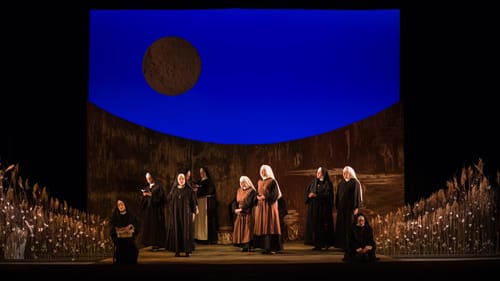Stay in the Loop
BSR publishes on a weekly schedule, with an email newsletter every Wednesday and Thursday morning. There’s no paywall, and subscribing is always free.
Two-thirds of the triptych
OperaDelaware presents Puccini's 'Il Tabarro' and 'Suor Angelica'

Puccini had little mercy on opera impresarios when he composed his triple bill of masterful one-acts, Il Trittico (The Triptych), which premiered in 1918 at the Metropolitan Opera. The three works are connected by genius, and each, in different ways, deals with a concealed death.
Staging and casting challenges create hurdles to mounting the three operas in one evening (as Puccini mandated), but OperaDelaware has overcome this classic production dilemma. General director Brendan Cooke broke the triptych into two excellent and widely different evenings by adding a contemporary Puccini sequel to his original three.
Love on the rocks
The Wilmington company began its centenary celebration with a splendid, moving production of Trittico’s first two short, sung-through operas: Il Tabarro (The Cloak) and Suor Angelica.
The evening opens with Tabarro, a gritty tale of boatmen anchored by a tragic love triangle. With its succinct dramatic sweep, Tabarro is often considered Puccini’s most modern work. The curtain rises in silence on the interior of a barge owned by Michele (baritone Grant Youngblood), a devoted but uncommunicative husband who lives on the boat with his much younger wife Giorgetta (soprano Eleni Calenos). She longs to escape her itinerant life (and confining, troubled marriage) and return to Paris.
It is the one-year anniversary of their child’s death, and the barge — soon moving on to Rouen — is docked on the Seine. Giorgetta falls for Luigi (tenor Matthew Vickers), one of her husband’s temporary workers who also longs for city life, and their passion leads to violence.
Tabarro’s success depends on a baritone with a dramatic range that can believably change (in a literal heartbeat) from sympathetic to a man capable of ultimate revenge. A perfect Verdi baritone with a chocolaty chiaroscuro of both darkness and brilliance, Youngblood delivered everything the work requires in a masterful interpretation. When Michele suddenly — and viciously — calls his wife a slut, there were audible gasps in the house.
Calenos gave an exceptionally musical and heartfelt interpretation of a woman torn between her desire to be faithful and her need for an independent life. And as her paramour, tenor Vickers has a romantic presence and the ample, bright squillo to ride Puccini’s lush orchestration.

A tour-de-force
After intermission, the curtain rose on the serene convent garden of Suor Angelica, Puccini’s equally riveting tale of a different kind of love and loss.
Sister Angelica, a former noblewoman, has been sequestered in the convent for seven years. As the opera opens, she and her fellow nuns all harbor worldly desires, with Angelica pining for word from her long-silent family.
During a hostile visit from her aunt, La Zia Principessa (forceful contralto Alissa Anderson), Angelica discovers that her illegitimate son — the reason for her banishment to the convent — has died. She prepares to commit suicide and join him in heaven, but receives a redemptive vision.
Like Tabarro, this work depends on the musical strength and dramatic gifts of its lead. As before, this operatic necessity is magnificently fulfilled. In her tour-de-force performance, Calenos (a powerful, rich spinto soprano) traces Angelica’s heartbreaking descent from anguish into trancelike despair.
Around these leading performers, OperaDelaware has gathered a first-rate company of uniformly excellent singers, well matched and fully invested in their roles. Maestro Anthony Barrese, OperaDelaware’s music director, led his fine orchestra in perfectly calibrated renditions of both great — and greatly different — scores.

In Tabarro, he evoked the river’s sweep and the pathos of a working life punctuated by sounds of Paris (including Puccini’s groundbreaking car horn). In Suor, he moved the orchestra skillfully from a winsome depiction of convent life to the sustained, intense drama of Angelica’s final moments.
Inspired design
In both shows, stage director Crystal Manich made choices that often enlivened and deepened the action. For Tabarro, she placed the action inside the barge, with much of the longed-for Parisian life, including an enticing chorus, tauntingly offstage.
In Suor, the nuns were in sometimes obvious groupings, but Angelica’s confrontation with her aunt and her final moments were staged with force and impact. Manich made savvy use of the Grand’s intimacy by creatively reinforcing Tabarro’s claustrophobia and the constricted life of Suor’s convent.
Inspired design choices added immeasurably to both operas. Stephen Dobay’s modular set pieces functioned equally well to create both barge and convent, though the boat’s steep stairs made for periodic difficulty among the cast. Tláloc López-Watermann’s thrilling lighting design created totally different worlds. The moody, watery aura of Tabarro and Suor’s luminous late-afternoon garden became the shadowy stripes of convent-parlor shutters and white rays of divine light in the opera’s final ethereal vision.
In an additional centenary homage, all four festival works were set in 1918 (when Puccini wrote them), affording thoughtful, welcome continuity. Throughout the evening, the creative team focused attention on the music and singers, welcome in an age of overwrought staging that is sometimes an end in itself.
Accounting for changing audience desires and spiraling presentation costs, opera companies worldwide are opting for festival models like this. Repeating both works on consecutive weekends, OperaDelaware again used its resources — and those of its singers and creative team — to maximum artistic effect.
What, When, Where
Il Tabarro and Suor Angelica (Parts I and II of "Il Trittico"). By Giacomo Puccini, libretti by Giuseppe Adam and Giovacchino Forzano, Anthony Barrese conducted, Crystal Manich directed. Through May 6, 2018, at the Grand Opera House, 818 N. Market Street, Wilmington, Delaware. (302) 442-7807 or operade.org.
Sign up for our newsletter
All of the week's new articles, all in one place. Sign up for the free weekly BSR newsletters, and don't miss a conversation.

 Gail Obenreder
Gail Obenreder